PMSG-Based Black-Start Technology and Its Field Tests
Abstract
:1. Introduction
2. Black-Start Scheme
2.1. Situation on Site
2.2. Black-Start System
2.3. Black-Start Scheme
3. Analysis of the Test Results
3.1. Lb Access
3.2. WPU Self-Starting
3.3. Black Starting La
3.4. Splitting Process
4. Conclusions
- (1)
- A wind farm configured with an external power supply, balanced load and coordinated controls has black-start capability.
- (2)
- The self-starting and black starting are susceptible to wind speed and system disturbances. The slower the black-start process, the smaller the voltage and frequency impact of the system.
- (3)
- The external power supply provides voltage and frequency support and main power for the black start of the power grid.
- (4)
- The output of the WPUs relatively lags the rapid power demand of the black start. The power of the black start is mainly provided by the external power supply.
- (5)
- The magnitude of the reverse power of the external power supply is related to factors such as its initial output power, the power adjustment value and the preset time of WPUs.
5. Future Studies
- (1)
- Poor voltage and frequency stability, high real-time requirements and quick system status changes are observed during the wind farms’ participation in the black-start process, so coordinated control strategies and devices to synchronize the steps and control the transients need to be further studied.
- (2)
- When the auxiliary power of the black-start thermal power plant is large, the soft start technology and frequency conversion devices can be used as an effective means to improve the stability of the black-start system and to minimize the configuration capacity of the external power supply.
- (3)
- It is known that most of operating WPUs do not have the ability to stabilize voltage and frequency. Therefore, in order to promote the application of wind farms to participate in a black start, a new technology such as a virtual synchronous machine could be used to study the WPU body.
Author Contributions
Funding
Conflicts of Interest
References
- Golshani, A.; Sun, W.; Zhou, Q.; Zheng, Q.P.; Hou, Y. Incorporating Wind Energy in Power System Restoration Planning. IEEE Trans. Smart Grid 2019, 10, 16–28. [Google Scholar] [CrossRef]
- Sun, L.; Peng, C.; Hu, J.; Hou, Y. Application of Type 3 Wind Turbines for System Restoration. IEEE Trans. Power Syst. 2018, 33, 3040–3051. [Google Scholar] [CrossRef]
- Becker, H.; Naranovich, A.; Hennig, T.; Akbulut, A.; Mende, D.; Stock, S.; Hofmann, L. System restoration using VSC-HVDC connected offshore wind power plant as black-start unit. In Proceedings of the European Conference Power Electronics and Applications, Warsaw, Poland, 11–14 September 2017. [Google Scholar]
- Kai, S.; Yunhe, H.; Wei, S.; Junjian, Q. Renewable and Energy Storage in System Restoration. In Power System Control Under Cascading Failures: Understanding, Mitigation, and System Restoration; IEEE: Piscataway, NJ, USA, 2019; pp. 295–356. [Google Scholar] [CrossRef]
- Li, C.; Zhang, S.; Zhang, J.; Qi, J.; Li, J.; Guo, Q.; You, H. Method for the Energy Storage Configuration of Wind Power Plants with Energy Storage Systems used for Black-Start. Energies 2018, 11, 3394. [Google Scholar] [CrossRef]
- Aktarujjaman, M.; Kashem, M.A.; Negnevitsky, M.; Ledwich, G. Black start with dfig based distributed generation after major emergencies. In Proceedings of the 2006 International Conference on Power Electronic, Drives and Energy Systems, Trivandrum, India, 12–15 December 2006. [Google Scholar]
- Bizon, E.G.d.A.; Melo, F.D.S.d.; Salim, K.C.d.O. Analysis of insertion of wind power plants in the process of fluent restoration of the Brazilian interconnected power system. In Proceedings of the 2018 Simposio Brasileiro de Sistemas Eletricos (SBSE), Niteroi, Brazil, 12–16 May 2018. [Google Scholar]
- Jianfeng, D.; Yi, T.; Qi, W.; Xianbo, D.; Chenlong, L.; Lixin, F. Black start technology for local power grid via PMSG-based wind power generation. In Proceedings of the IEEE 3rd International Future Energy Electronics Conference and ECCE Asia (IFEEC 2017–ECCE Asia), Kaohsiung, Taiwan, 3–7 June 2017. [Google Scholar]
- Janning, J.; Schwery, A. Next generation variable speed pump-storage power stations. In Proceedings of the 13th European Conference on Power Electronics and Applications, Barcelona, Spain, 8–10 September 2009. [Google Scholar]
- Hu, Y.; Yu, Z.; Deng, C.; Wang, J.; Li, Y. Cause of generator startup failure during black-start of national wind/photovoltaic/energy-storage pilot station and its countermeasure. Electr. Power Autom. Equip. 2016, 37, 50–60. [Google Scholar] [CrossRef]
- Wang, A.; Gang, H.; Qiu, P.; Luo, X.; Pang, X.; Zhang, C. Self-Starting Analysis of New Energy System with Wind Power and Energy Storage. In Proceedings of the 37th Chinese Control Conference (CCC), Wuhan, China, 25–27 July 2018. [Google Scholar]
- Yuan, H.; Mi, Z.; Du, P.; Wan, Y.; Liu, L. Research of the transformer energization control strategy applied for storage-based wind farm self-start. In Proceedings of the IEEE Information Technology, Networking, Electronic and Automation Control Conference, Chengdu, China, 20–22 May 2016. [Google Scholar]
- Nuschke, M. Development of a microgrid controller for black start procedure and islanding operation. In Proceedings of the IEEE 15th International Conference on Industrial Informatics (INDIN), Poitiers, France, 24–26 July 2017. [Google Scholar]
- Thale, S.; Agarwal, V. A smart control strategy for the black start of a microgrid based on PV and other auxiliary sources under islanded condition. In Proceedings of the 37th IEEE Photovoltaic Specialists Conference, Seattle, WA, USA, 19–24 June 2011. [Google Scholar]
- Wei, T.; Hongtao, W.; Yingzhe, J. Construction and control strategy research of black start unit containing wind farm. In Proceedings of the Tencon IEEE Region, 10th Conference, Macao, China, 1–4 November 2015. [Google Scholar]
- Ye, M.; Liu, Y.; Du, K.; Gu, X. Black start scheme formation considering dynamic wind power penetration limit. In Proceedings of the 5th IET International Conference on Renewable Power Generation (RPG) 2016, London, UK, 21–23 September 2016. [Google Scholar]
- Xu, Z.; Yang, P.; Zeng, Z.; Zhang, Y.; Peng, J.; Zheng, Q. Study on black start strategy for multi-microgrids. In Proceedings of the IEEE Innovative Smart Grid Technologies-Asia (ISGT-Asia), Melbourne, VIC, Australia, 28 November–1 December 2016. [Google Scholar]
- Tang, Y.; Dai, J.; Wang, Q.; Feng, Y. Frequency Control Strategy for Black Starts via PMSG-Based Wind Power Generation. Energies 2017, 10, 358. [Google Scholar] [CrossRef]
- Li, C.; Zhan, P.; Wen, J.; Yao, M.; Li, N.; Lee, W. Offshore Wind Farm Integration and Frequency Support Control Utilizing Hybrid Multiterminal HVDC Transmission. IEEE Trans. Ind. Appl. 2014, 50, 2788–2797. [Google Scholar] [CrossRef]
- Li, J.; Su, J.; Yang, X.; Zhao, T. Study on microgrid operation control and black start. In Proceedings of the 4th International Conference on Electric Utility Deregulation and Restructuring and Power Technologies (DRPT), Weihai, Shandong, China, 6–9 July 2011. [Google Scholar]
- Wang, J.; Mu, L.; Zhang, F.; Zhang, X. A Parallel Restoration for Black Start of Microgrids Considering Characteristics of Distributed Generations. Energies 2018, 11, 1. [Google Scholar] [CrossRef]
- Liu, L.; Wu, J.; Mi, Z.; Sun, C. A feasibility study of applying storage-based wind farm as black-start power source in local power grid. In Proceedings of the International Conference on Smart Grid and Clean Energy Technologies (ICSGCE), Chengdu, China, 19–22 October 2016. [Google Scholar]
- Li, L.; Yuechao, W.; Yi, Z. The energy storage system control research based on black-start. In Proceedings of the China International Conference on Electricity Distribution (CICED), Shenzhen, China, 23–26 September 2014. [Google Scholar]
- Yeting, W.; Yuxing, D.; Xiwei, Z.; Ye, W.; Bin, X. Application of island microgrid based on hybrid batteries storage. In Proceedings of the International Conference on Renewable Energy Research and Application (ICRERA), Brasov, Romania, 19–22 October 2014. [Google Scholar]
- Valle, R.G.d.; Cotorogea, M.; Rabelo, B.; Hofmann, W. On the Emulation of an Isolated Wind Energy Conversion System: Experimental Results. In Proceedings of the Electronics, Robotics and Automotive Mechanics Conference (CERMA), Cuernavaca, Mexico, 22–25 September 2009. [Google Scholar]
- Zhu, L.; Pan, Z.; Xu, G. Black Start with DFIG-Based Wind Turbines Using Improved Virtual Synchronous Control. In Proceedings of the 21st International Conference on Electrical Machines and Systems (ICEMS), Jeju, Korea, 7–10 October 2018. [Google Scholar]
- Xu, Z.; Yang, P.; Zhang, Y.; He, T.; Peng, J.; Zheng, Q. Control devices development of residential single-phase PV-ESS microgrid. In Proceedings of the IEEE Innovative Smart Grid Technologies–Asia (ISGT-Asia), Melbourne, Australia, 28 November–1 December 2016. [Google Scholar]
- Xu, Z.; Yang, P.; Zeng, Z.; Peng, J.; Zhao, Z. Black Start Strategy for PV-ESS Multi-Microgrids with Three-Phase/Single-Phase Architecture. Energies 2016, 9, 372. [Google Scholar] [CrossRef]
- El-Zonkoly, A.M. Renewable energy sources for complete optimal power system black-start restoration. IET Gener. Transm. Distrib. 2015, 9, 531–539. [Google Scholar] [CrossRef]
- Xiaoyu, S. The “black start” test of the National Scenery Storage and Loss Demonstration Power Station was successful. State Grid News, 14 October 2014. [Google Scholar]
- Lei, H.; Yan, X.; Xinyan, X. The first domestic wind power black start test was completed by State Grid Jiangsu Jiangsu Electric Power Co., LTD. State Grid News, 10 August 2017. [Google Scholar]
- Bahrman, M.; Bjorklund, P. The New Black Start: System Restoration with Help from Voltage-Sourced Converters. IEEE Power Energy Mag. 2014, 12, 44–53. [Google Scholar] [CrossRef]
- Blasco-Gimenez, R.; Villalba, S.A.; Rodríguez-D’Derlée, J.; Bernal-Pérez, S. Diode based HVDC link for the connection of large off-shore wind farms with self start capability. In Proceedings of the 14th European Conference on Power Electronics and Applications, Birmingham, UK, 30 August–1 September 2011. [Google Scholar]
- Jie, D.; Harley, R.G. Islanded microgrids black start procedures with wind power integration. In Proceedings of the IEEE Power & Energy Society General Meeting, Vancouver, BC, Canada, 21–25 July 2013. [Google Scholar]
- Li, L.; Songjie, S.; Gang, W. The control strategy research of wind power and storage based on the black start. In Proceedings of the China International Conference on Electricity Distribution, Shenzhen, China, 23–26 September 2014. [Google Scholar]




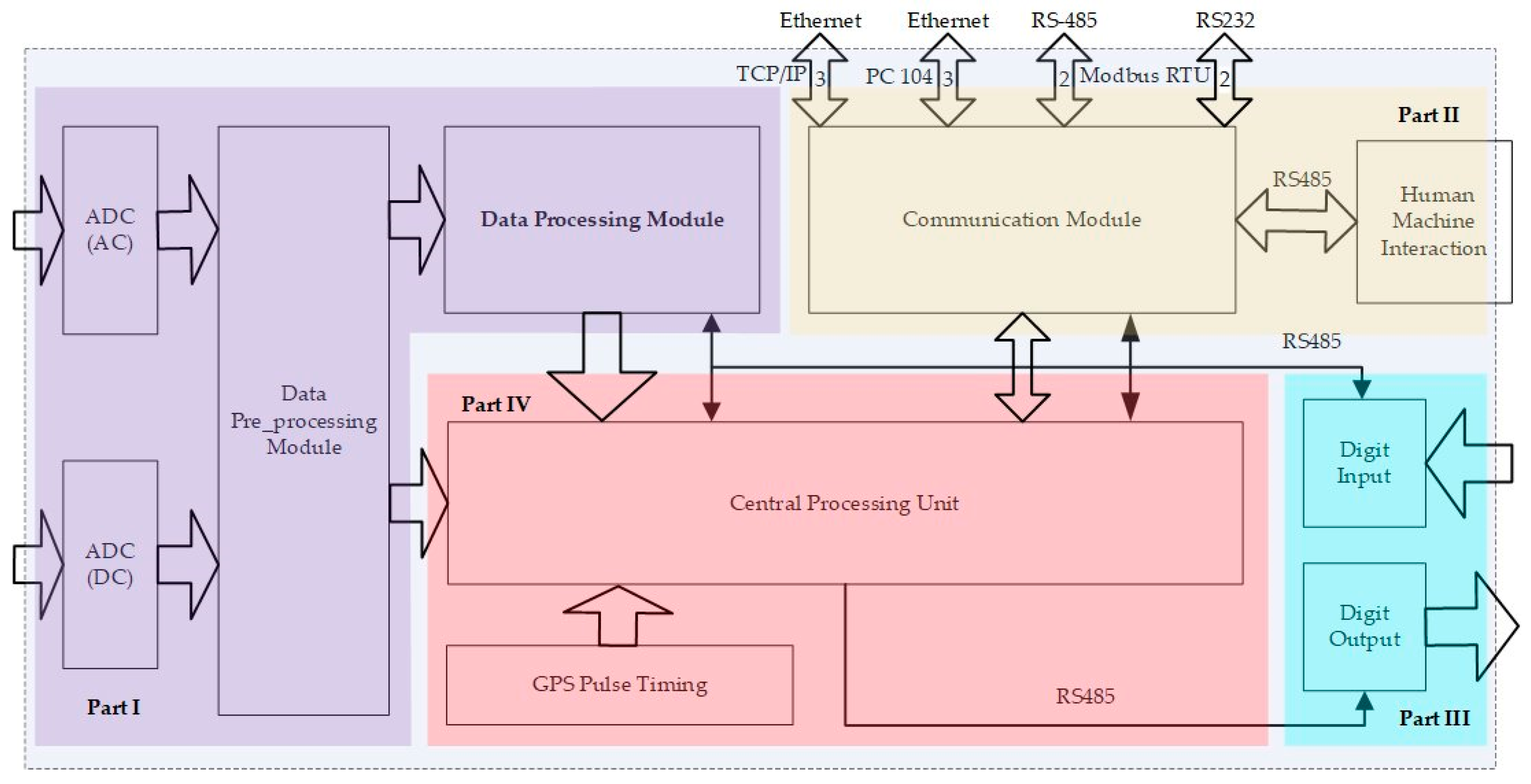
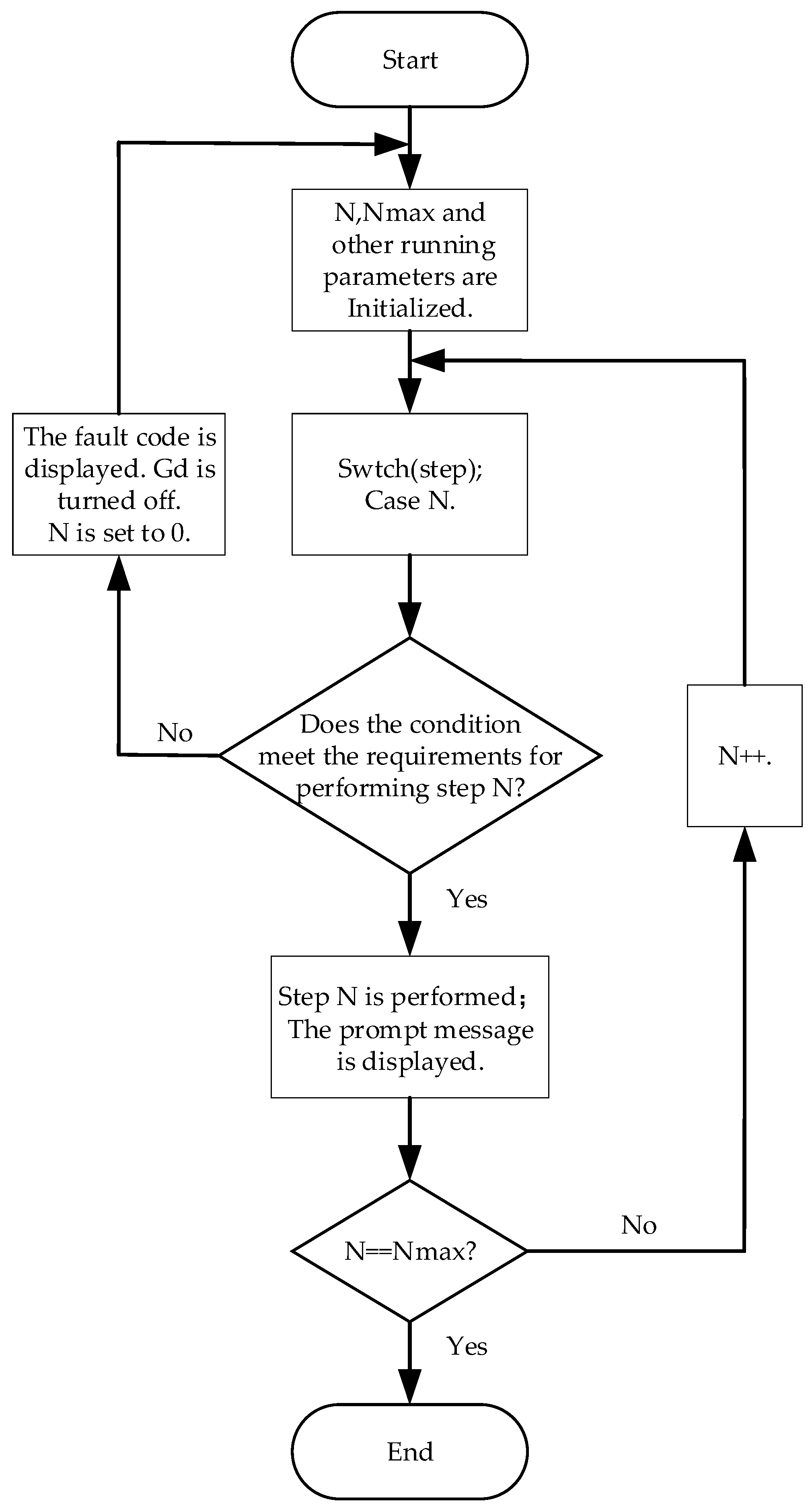

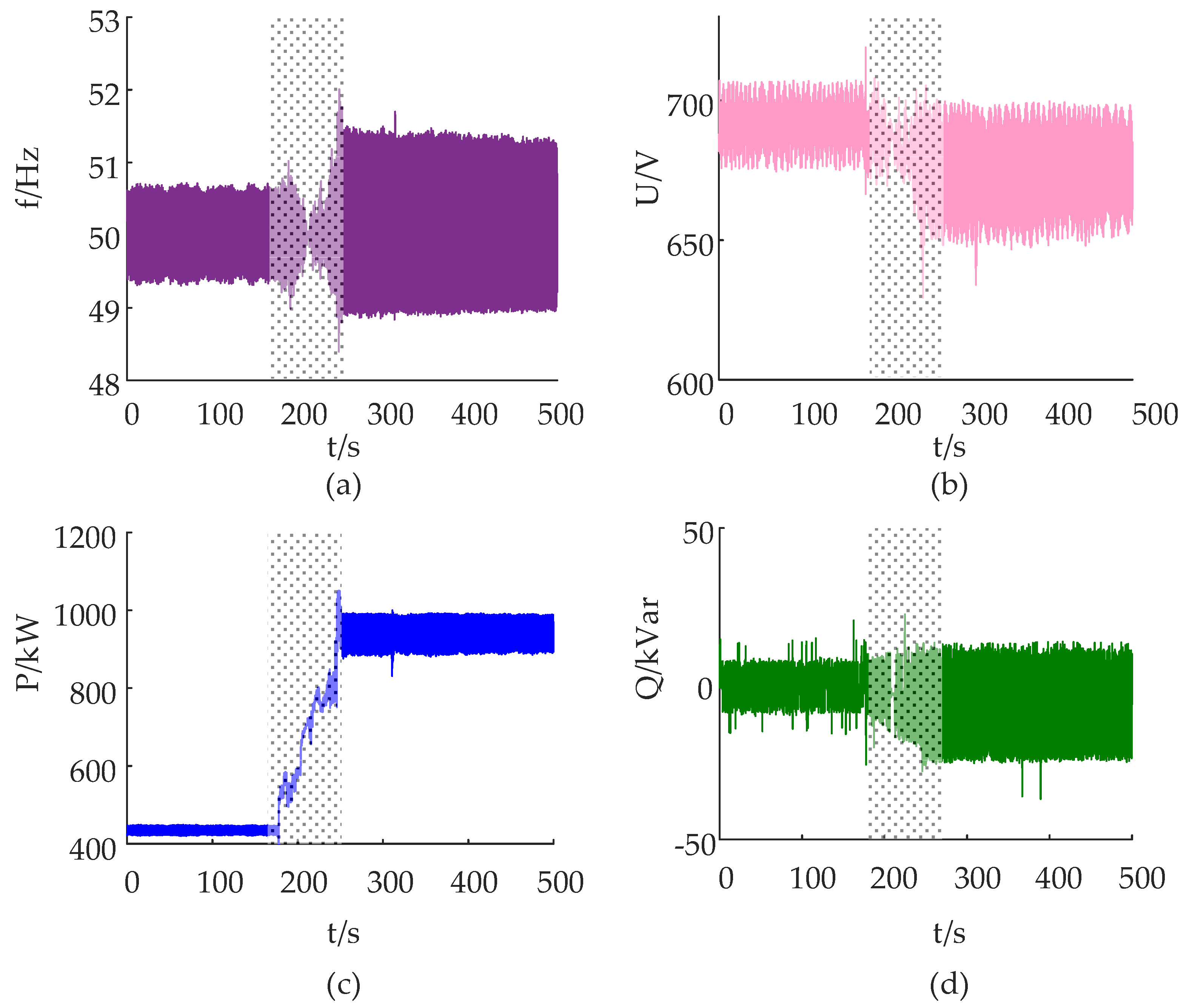
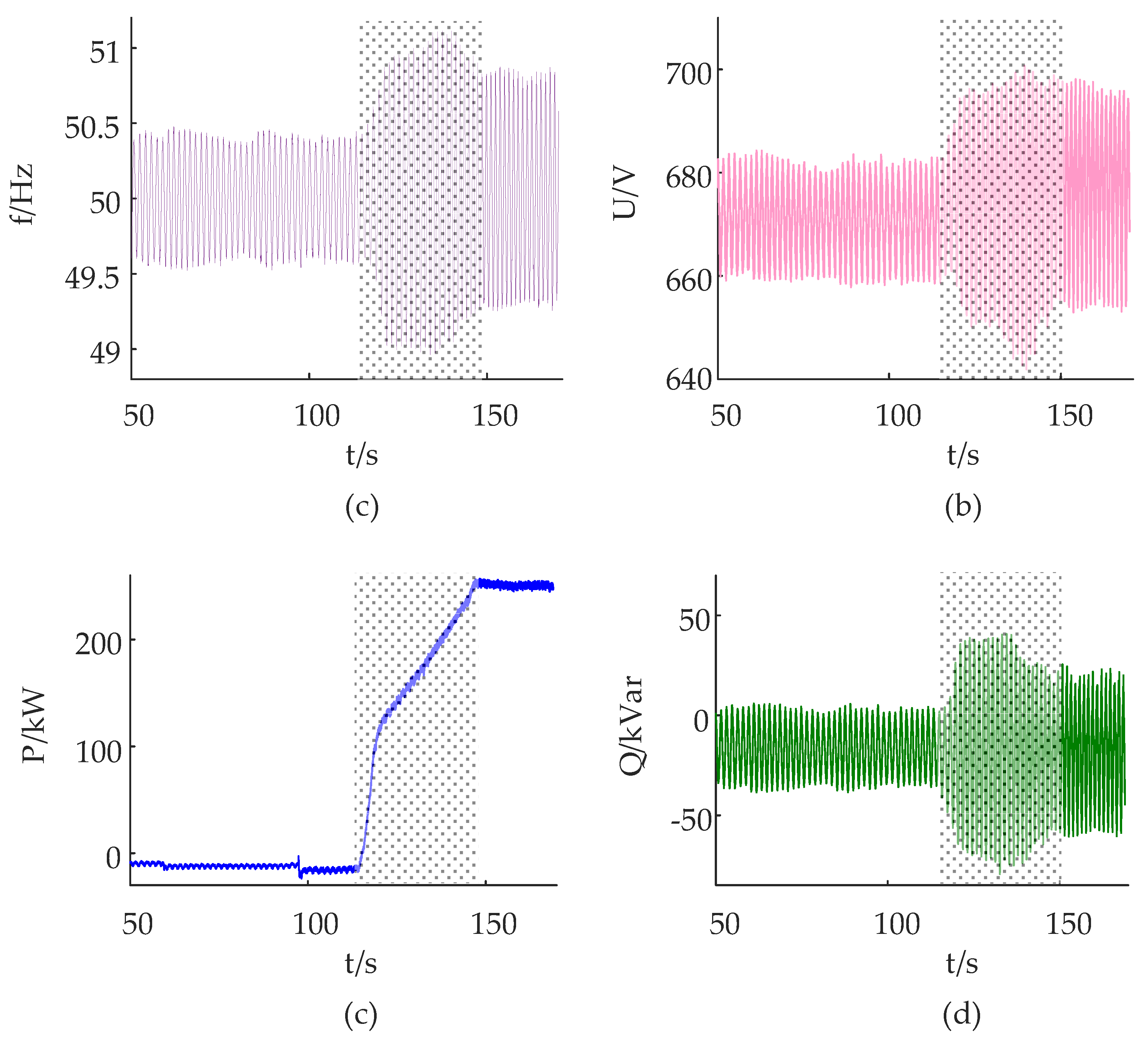
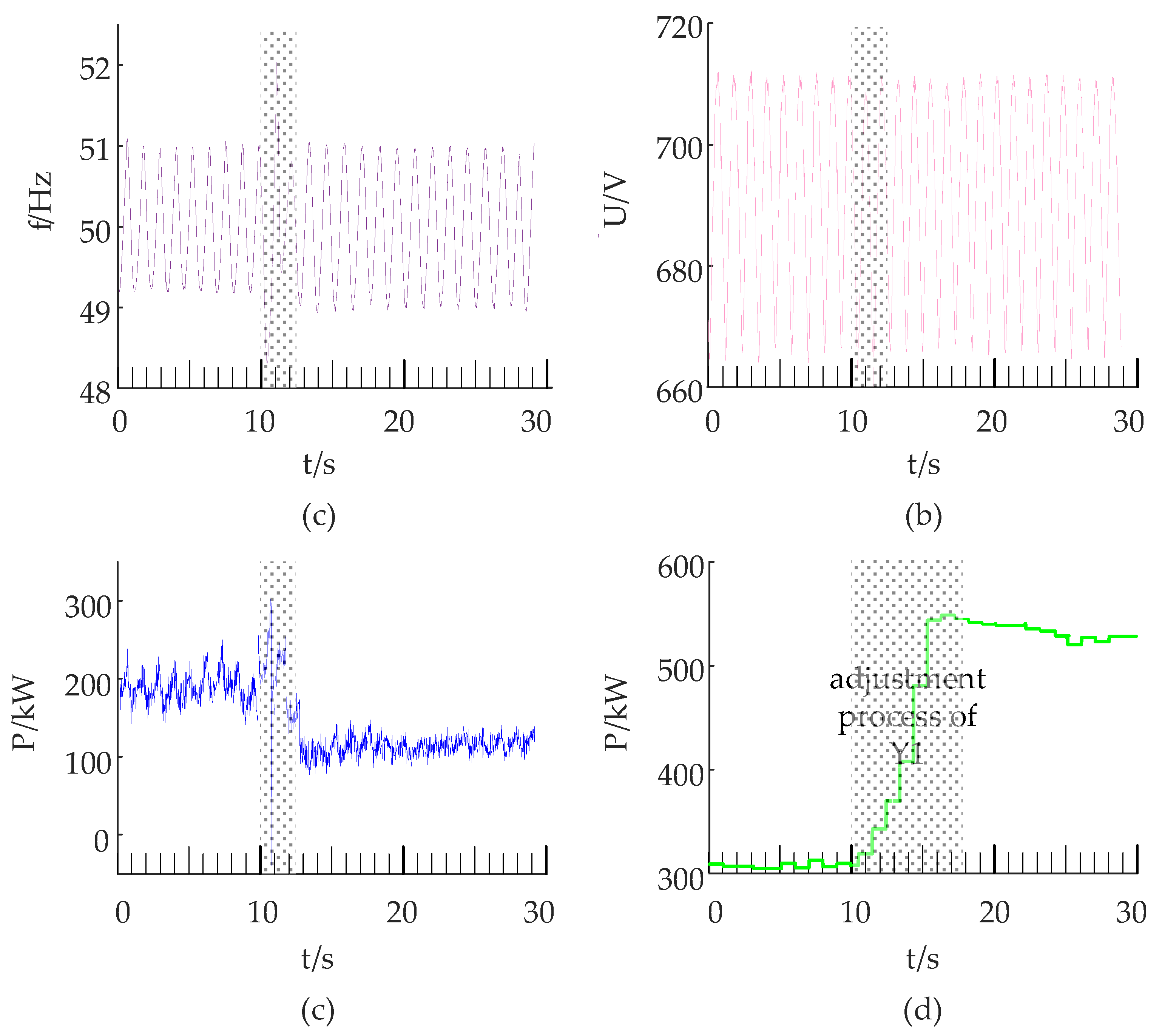
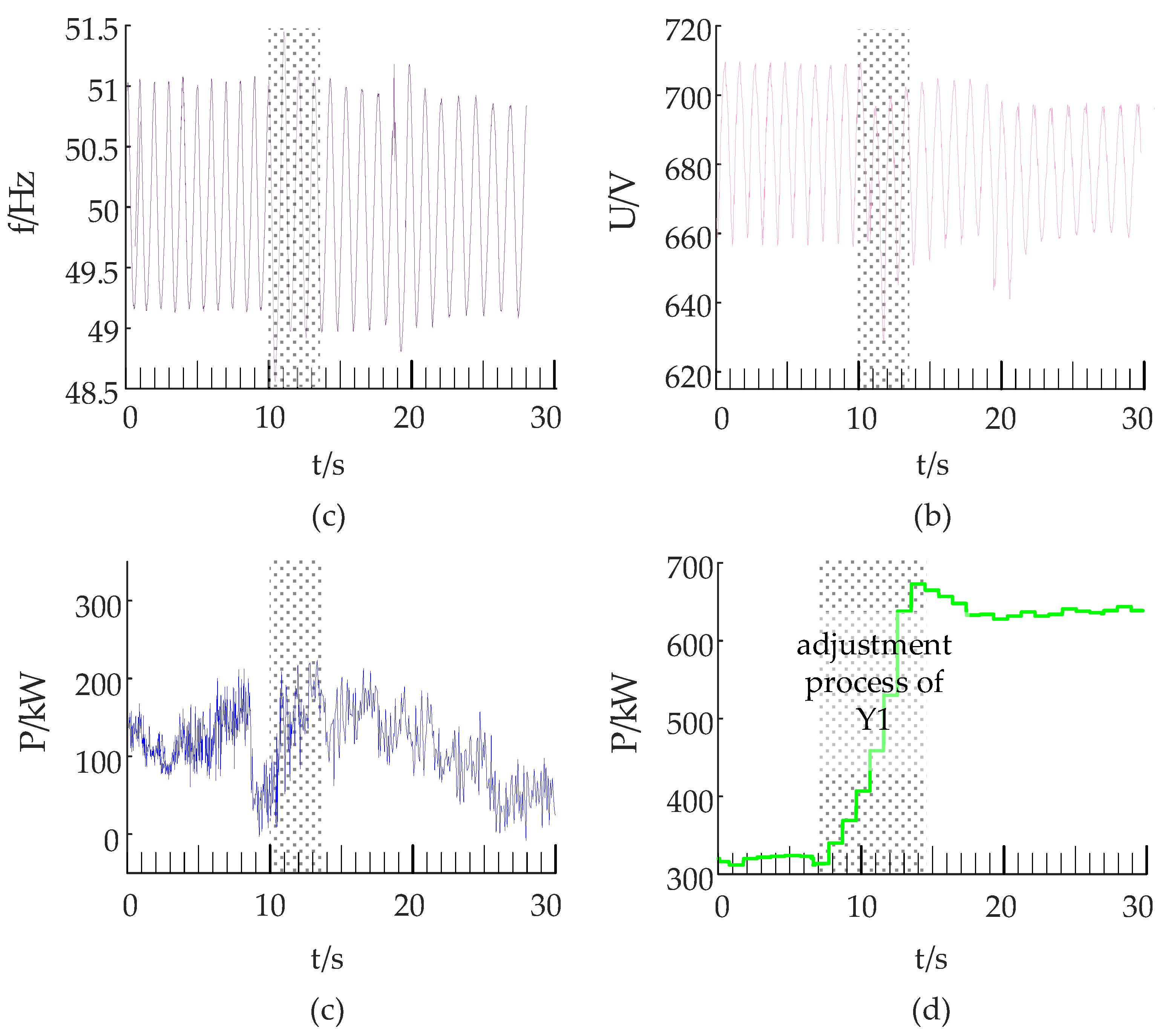
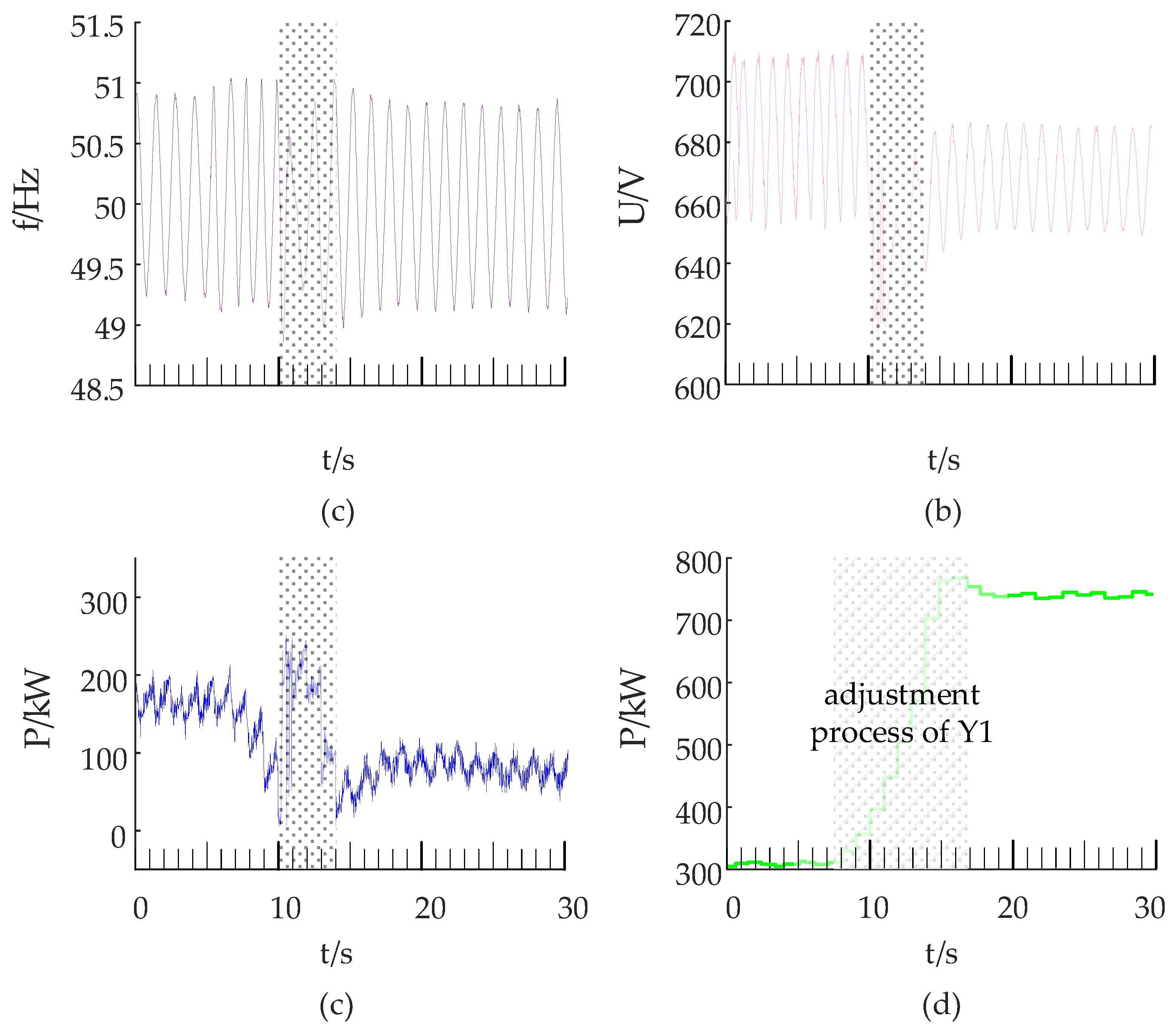
| Symbol | Equipment | Type |
|---|---|---|
| Gd | diesel generator | 400 kW |
| La | auxiliary machine in thermal power | 690 V/3000 kVA |
| Lb | balanced load | 690 V/1000 kVA |
| G1, G2 | PMSG | GW115/2000 kW |
| M1, M2 | cabin equivalent load | 40–60 kVA |
| CV1, CV2 | full-power converter | GW115/2000 kW |
| T100 | step-up transformer | 500 kVA |
| T101, T201, T301 | box-type transformer | 2200 kVA |
| T102, T202 | cabin load transformer | 90 kVA |
| QF101 | circuit breaker for Gd | 400 V–2000 A |
| QF102, QF202 | circuit breaker for WPU | 690 V–2000 A |
| QF103, QF203 | circuit breaker for full-power converter | 690 V–2000 A |
| QF104, QF204 | circuit breaker for cabin equivalent load | 400 V–100 A |
| QF302 | circuit breaker for load | 400 V–1500 A |
| QF106, QF206, QF306 | circuit breaker for box-type transformer | 35000 V–100 A |
| Sequence | Parameter | Value | Parameter | Value | Parameter | Value |
|---|---|---|---|---|---|---|
| Part 1 | Umax | 707.5 V | Umin | 669.65 V | Voltage fluctuation | 2.95% |
| fmax | 50.71 Hz | fmin | 49.24 Hz | Frequency fluctuation | 1.52% | |
| Qmax | 8.6 kVar | Qmin | −16.6 kVar | |||
| Part 2 | Umax | 718.2 V | Umin | 629.22 V | Voltage fluctuation | 8.81% |
| fmax | 52.01 Hz | fmin | 48.391 Hz | Frequency fluctuation | 4.03% | |
| Qmax | 22.3 kVar | Qmin | −28.1 kVar |
| No. | Wind Speed | Parameter | Max | Min | Max Fluctuation Ratio(%) | Result |
|---|---|---|---|---|---|---|
| 1 | 5.85 m/s | U (V) | 715.98 | 689.66 | 3.80 | Last 11 s successful |
| I (A) | 272.41 | / | / | |||
| f (Hz) | 50.60 | 49.30 | 1.41(0.71 Hz) | |||
| 2 | 2.55 m/s | U (V) | 714.49 | 652.1 | 5.60 | Last 83 s successful |
| I (A) | 223.83 | / | / | |||
| f (Hz) | 51.13 | 48.94 | 2.25(1.1 Hz) | |||
| 3 | 4.26 m/s | U (V) | 823.47 | 568.91 | 19.34 | Failed |
| I (A) | 418.65 | / | / | |||
| f (Hz) | 52.39 | 47.29 | 5.42(2.7 Hz) | |||
| 4 | 5.91 m/s | U (V) | 822.17 | 565.32 | 19.16 | Failed |
| I (A) | 427.09 | / | / | |||
| f (Hz) | 52.739 | 46.41 | 7.18(3.6 Hz) | |||
| 5 | 4.53 m/s | U (V) | 818.99 | 562.64 | 18.70 | Failed |
| I (A) | 384.13 | / | / | |||
| f (Hz) | 52.35 | 47.72 | 4.70(2.4 Hz) | |||
| 6 | 3.65 m/s | U (V) | 695.72 | 640.05 | 7.24 | Last 32 s, successful |
| I (A) | 231.81 | / | / | |||
| f (Hz) | 51.12 | 49.00 | 2.24(1.1 Hz) |
| Sequence | Parameters | Value | ||
|---|---|---|---|---|
| Initial state before black start | Power of La (kW) | 100 | 200 | 300 |
| Initial voltage (V) | 690.0 | 710.0 | 710.0 | |
| Preadjusted power (kW) | 200 | 300 | 400 | |
| Preadjusted time (s) | 5.0 | 5.0 | 4.5 | |
| Main parameters of the black start process | Max power of Gd (kW) | 280 | 250 | 230 |
| Min power of Gd (kW) | −67 | −20 | −5 | |
| Max Voltage (V) | 710.4 | 710.2 | 710.7 | |
| Min voltage (V) | 620.2 | 629.1 | 650.2 | |
| Max frequency (Hz) | 52.06 | 51.43 | 51.09 | |
| Min frequency (Hz) | 48.31 | 48.57 | 49.15 | |
| Startup duration (s) | 1.5 | 2.2 | 3.2 | |
© 2019 by the authors. Licensee MDPI, Basel, Switzerland. This article is an open access article distributed under the terms and conditions of the Creative Commons Attribution (CC BY) license (http://creativecommons.org/licenses/by/4.0/).
Share and Cite
Tan, M.-g.; Tang, Y.; Zhang, C. PMSG-Based Black-Start Technology and Its Field Tests. Energies 2019, 12, 2144. https://doi.org/10.3390/en12112144
Tan M-g, Tang Y, Zhang C. PMSG-Based Black-Start Technology and Its Field Tests. Energies. 2019; 12(11):2144. https://doi.org/10.3390/en12112144
Chicago/Turabian StyleTan, Min-gang, Yi Tang, and Chaohai Zhang. 2019. "PMSG-Based Black-Start Technology and Its Field Tests" Energies 12, no. 11: 2144. https://doi.org/10.3390/en12112144





